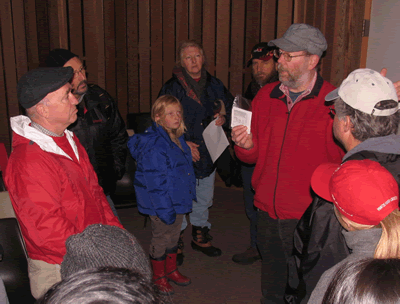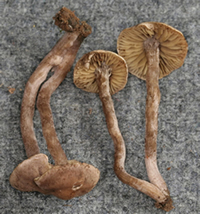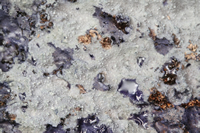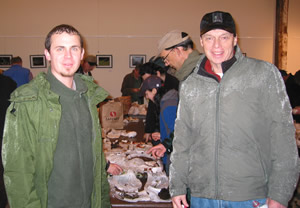point reyes mycoblitz
What is a mycoblitz?
A mycoblitz is a quick, intense survey of the fungal species present. The Point Reyes Mycoblitz was structured into two "forays" or mass collecting efforts. Over 125 people participated in the first mycoblitz on December 10, 2005. We have now completed five mycoblitz forays at Point Reyes. Collecting was focused on 47 trail- and road-based zones (download a PDF of the routes). We targeted only macrofungi (i.e., those that produce macroscopic fruiting structures such as mushrooms).

Dr. Tom Bruns instructs participants
in the Bear Valley Visitor Center Auditorium
© photo by Hugh Smith
Identifications of the collections were done in two steps. Sorting into major groups, and identification of the most common and easily recognized species was done on the first day. We were able to use the Bear Valley Red Barn classroom for several pre-sort sessions. This process was followed by more careful scrutiny of the specimens on the second day in a lab where microscopes and reference books were available. Specimens were also photographed and dried on the second day. Many of the specimens still need to be examined more closely to confirm our preliminary identifications.
The purpose of the mycoblitz
The primary goal of the Point Reyes Mycoblitz is to produce vouchered records of all the macrofungi of the Pt. Reyes National Seashore. The motivation for this goal is derived from the observation that there are reasonably good records for animals and plants of the park, but not for fungi. Yet fungi are important components of the Point Reyes environment. They are the primary recyclers of wood and other lignified plant material; they are typically the most abundant and important group of plant pathogens; they form mutualistic interactions (i.e., mycorrhizae) with most plants; they are crucial components in soil food webs; they are an important food source for many small mammals; and they associate with insects in a huge diversity of symbiotic interactions. Macrofungi, such as the mushroom-forming basidiomycetes, are also a group that inspires much interest from the general public because of their diversity of forms, the edibility of some, and the extreme toxicity of others.

Sorting at the Red Barn Classroom after the foray
© photo by Hugh Smith
A second goal of the mycoblitz is to increase the awareness of fungi with the general public. BAMS addressed this goal at the Bear Valley Visitor Center by presenting lectures, exhibiting fungi, and talking with the public at three well-attended fungus fairs.
Our strategy
Our collecting was focused on native forest, scrub, and dune communities, although trailheads, picnic areas, and other disturbed habitats were also surveyed. Agricultural areas were excluded. Maps and a list of specific areas that were targeted are here as a PDF file.
A summary of collections reported from each zone shows a huge difference between zones, but this pattern probably does not reflect fungal diversity at these sites. Instead it is an indicator of the most popular and accessible sites, and the taxonomic expertise and interest of the people that collected particular areas. An Excel graph of the fungi collected can be found here.
Blank field labels for the mycoblitz can be found here.
How many fungi are at Point Reyes?
We don't know the answer to that question. We now have records for over 450 macrofungi from Point Reyes, and the accumulation curve for our collections suggests that there are many more to be found. Even if we had found all of the macrofungi, this would be a small subset of all the fungi.
Have you found any new species?
 |
Yes! Pseudobaeospora aphana is described as a new species in the March/April 2009 issue of Mycologia by Dr. Else Vellinga. According to the abstract, Pseudobaeospora aphana is characterized by a brownish pileus with a lilac sheen, a cutis of narrow hyphae on a subpellis of relatively wide and short cells, absence of cheilocystidia and colour changes in KOH, and abundant clamp connections. It was discovered during the January 2007 Mycoblitz at Point Reyes National Seashore, the fourth such event in an ongoing effort to inventory the mycoflora of this National Park. To read the full paper, click here. |
 Amaurodon sp. Photo by Mike Wood |
New species are easily missed because most of our current efforts have been focused on taxa we can identify. Those that are difficult often fall through the cracks due to the volume of collections that get processed within a two-day period. However, we do have indications that some of our collections may be new to science. For example the Amaurodon sp. is likely a new species. The only other described species in the genus with purple spores in water is from Australia. Some of our preliminary nucleotide sequence data from Inocybe species also suggest that some of the Point Reyes collections do not fit neatly within previously described and sequenced species. |
Who's involved?
The Point Reyes Mycoblitz has been a collaboration between Dr. Tom Bruns, Point Reyes National Seashore, UC Berkeley, Humboldt State University (HSU), San Francisco State University (SFSU), the Bay Area Mycological Society (BAMS), Sacramento Area Mushroomers (formerly the Davis Mycological Society), Fungus Federation of Santa Cruz, Humboldt Bay Mycological Society, Mycological Society of San Francisco, and Sonoma County Mycological Association. Dr. Terry Henkel and his HSU graduate students also attended one or more forays. For one event, we brought in Dr. Steve Miller from the University of Wyoming. Dr. Else Vellinga and Dr. John Taylor (UC Berkeley), Dr. Michael Davis (UC Davis), Darvin DeShazer (SOMA), Debbie Viess (BAMS), J.R. Blair, Fred Stevens, Norm Andresen, and Mike Wood (MSSF), and a number of UC Berkeley and SFSU graduate students played a significant role. Many park visitors and local residents participated as well.
Acknowledgments

Dr. Ben Becker and David Rust © photo by Hugh Smith
We thank Dr. Ben Becker of the National Park Service for coordinating the mycoblitz with Point Reyes National Seashore, the staff at the Bear Valley Visitory Center for their patience with a biannual invasion of volunteers, the Department of Plant and Microbial Biology at UC Berkeley and Barbara Waaland for access to the teaching labs for the identification phase of the mycoblitzes, and all the people who volunteered their time to collect and identify fungi for science.
All content on this page © 2009 by Tom Bruns and David Rust

 back to top
back to top